Adaptive Integrated Guidance and Fault Tolerant Control Using Backstepping and Sliding Mode
Abstract
A new method of integrated guidance and control for homing missiles with actuator fault against manoeuvring targets is proposed. Model of the integrated guidance and control system in the pitch plane with actuator fault and some uncertainty is developed. A control law using combination of adaptive backstepping and sliding mode approaches is designed to achieve interception in the presence of bounded uncertainties and actuator fault. Simulation results show that new approach has better performance than adaptive backstepping and has good performance in the presence of actuator fault.
1. Introduction
The traditional way to design a missile guidance and control system is to form subsystems separately followed by integrating them. This method presents successful results and demonstrates some remarkable performance in designing several missile guidance and control systems. However, since in this method interactive relationships between the cooperating subsystems cannot be completely exploited, the overall system performance may be constrained. Therefore, a design method named as integrated guidance and control (IGC) system is provided by incorporating some control theories to enhance the performance of the whole system.
There are a variety of methods to solve IGC problem that some of them are presented in the following. In [1] an adaptive nonlinear IGC approach is proposed by adopting a backstepping scheme for missile-target engagement model with uncertainties without fault. Reference [2] has addressed IGC problem using nonlinear optimal control technique which is called θ-D method. In work [3] an integrated guidance and autopilot system is designed for homing missiles against ground fixed targets. To this intent, an integrated model in the pitch plane is formulated, and then the adaptive nonlinear control law is designed by adopting the sliding mode control approach. Also, other control theories have been employed in the design of guidance laws, including H∞ control [4], variable structure control [5], feedback linearization scheme [6], sliding mode control [7], and adaptive fuzzy sliding mode control [8].
A fault tolerant control system is capable of controlling a system with satisfactory performance even if one or several faults occur in the system. Fault tolerant control systems can be classified into two main families: passive fault tolerant controllers and active fault tolerant controllers. In a passive fault tolerant controller, deviations of the plant parameters from their actual values or deviations of the actuators from their expected position may be efficiently compensated by a fixed robust feedback controller [9]. Many control design laws described by fault tolerant control have been proposed in [10–12] for different practical systems. In [13] some fault tolerant controllers designed guidance strategy in the presence of actuator faults. Furthermore, authors of [14] have proposed a fault tolerant control for induction motors based on backstepping strategy.
In this paper, first, IGC system in the pitch plane with an actuator fault and some uncertainties is modelled. Since the actuator fault uncertainty is multiplied by input, we must use some scheme of such sliding mode. Then a control law using combination of adaptive backstepping and sliding mode is designed to achieve the interception in the presence of bounded uncertainties and actuator fault. The proposed control law is compared with control law of [1] for a free fault system. Then, the performance of designed law control is investigated for the faulty system.
The paper is organized as follows. In Section 2, missile-target engagement geometry will be derived in the pitch plane. In Section 3, actuator fault is modelled. In Section 4 control law is derived using the proposed new approach. In Section 5 control law is derived for the faulty system. Simulation results and their analysis are presented in Section 6. Finally, a conclusion is made in Section 7.
2. Engagement of Model Derivation
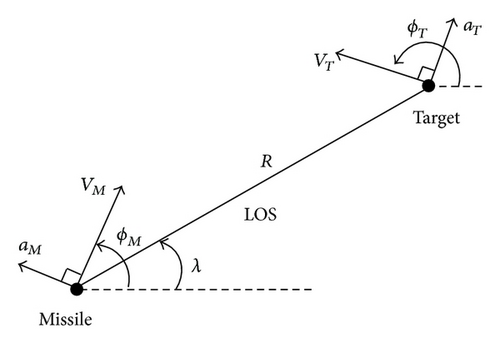
3. Modeling of Actuator Fault
4. Integrated Guidance and Control Design Using Combination of Sliding Control and Backstepping
System (8) is not in the standard form of common backstepping procedure because x2 appeared in the nonlinear term of cos(q + x2 − θ)a12. In order to deal with this situation, [1] has introduced an adaptive backstepping control scheme to design an IGC law that can zero LOS rate and maintain stability of the overall system.
5. Fault Tolerant Control Design
6. Numerical Results and Analysis
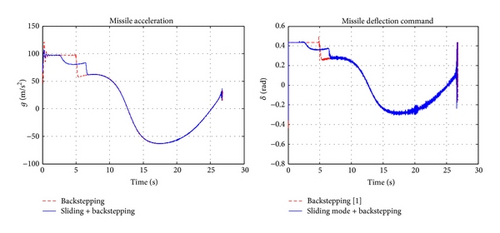
Next, performance of the proposed control law is investigated for faulty system. For this purpose, actuator effectiveness is selected between 30% and 100%; in other words 0.3 ≤ f < 1. It is assumed that the actuator commands are taken as a first-order lag system with a time constant 0.001 and limited by |δz| < 45 deg.
As can be seen in Figures 3–6, the controllers are robust to achieve the missile interception in the presence of the target acceleration and actuator fault. It is clear that the less efficiency of actuator increases the time to go, interception distance, and deflection angle for pitch control. Also, it increases the control effort (Figure 7).

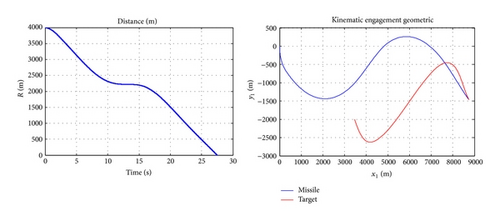
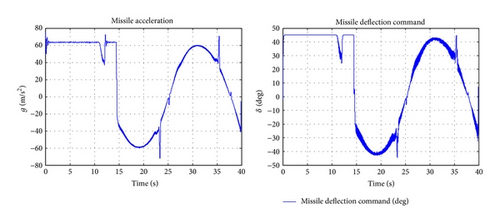
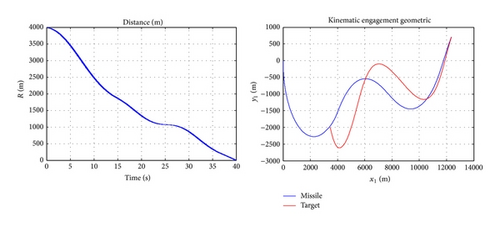
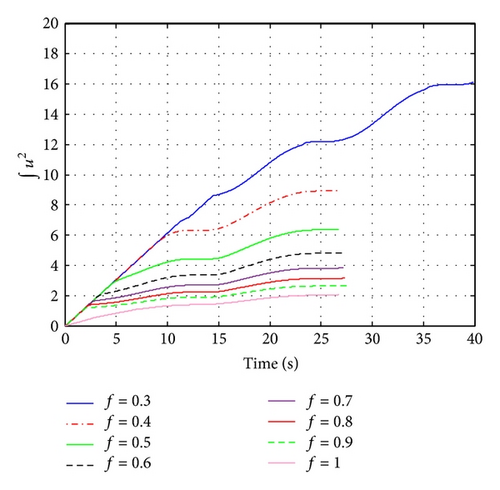
7. Conclusion
In this paper, we introduce a new approach to design of guidance laws for two-dimensional point mass missile-target engagement in the presence of bounded uncertainties and actuator fault. In proposed approach, sliding mode control is combined with adaptive backstepping to improve the performance. Numerical results show that the new control law has better performance than adaptive backstepping and has good performance in faulty system.
Conflict of Interests
The authors declare that there is no conflict of interests regarding the publication of this paper.




